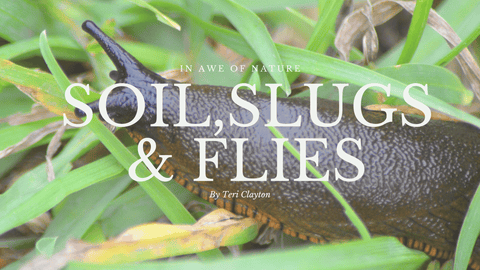How To Read Nature - Weeds

Part 1 - Weeds
Everything in nature happens for a reason - there are no random processes that do not serve some function or purpose.
Be humble when dealing with something you consider to be a problem, (like weeds), nature supports the growth of certain species for important reasons. When our small way of seeing things means we find ourselves going against nature, then we have something valuable to learn about what we are doing wrong.
When I see a weed growing - It tells me something about what nature needs. Most soil carries seeds that have been sown over many years - often hundreds of years and perhaps much much longer (who knows what potential plants lay in wait for us to discover). Seeds lay dormant, until the right conditions arise to activate their germination process. Some seeds require a prolonged frost followed by warmth, some require consistent high temperatures, yet still others require high salt levels and so on. Every plant's seeds have evolved to germinate only when the right conditions are present, for that plant to stand the best chance of survival and even then, many wild type seeds will carry a seemingly spontaneous and totally unpredictable germination process.
When certain plants grow - it is because certain conditions are present. Most of the troublesome weeds people encounter today are known as pioneer plants. They are plants that have evolved to quickly cover over exposed soils, after there has been some destructive event - like exposure to a pesticide, prolonged flooding, mineral depletion, microbial collapse, drought, fire or overgrazing. Exposed soils lead to devastating destruction of the life below ground and loss of organic matter into rivers and the air. Think silt running off farmers fields into rivers, or the infamous dust bowls of desertified land in America and Australia. Exposed soils are bad news for nature - they cause rapid evaporation of moisture from beneath the soil - leading to death of the life in the soil and poor water holding capacity, which further destroys soil structure. Exposed soils are the result of prolonged destruction and lead to reduced health and resilience of the life within an ecosystem.
Pioneer species have evolved specific characteristics to help them quickly cover the soil - enabling nature to rapidly recover and better support life both below the soil and above it. These characteristics are the ones that many gardeners and food growers struggle to deal with - because they are exquisitely designed to fufill their purpose and are seemingly unstoppable. These characteristics often include the production of copious amounts of tiny seed, that once released can never be eradicated, the seeds are small and numerous such that they stand the best chance of spreading out over the ground. They do not all germinate at the same, instead they do so in a staggered fashion. Some of these pioneer weeds develop deep tap roots, so they can reach deeply into the soil and bring minerals to the surface enabling other plants to access them, whilst others sprawl quickly just beneath the surface, covering a large area and weaving together the soil quickly. What you will discover is that the right weeds grow depending upon what nature needs. If the soil is dried up and dusty, with a thin layer of organic matter, often nettles will take hold - in a bid to weave the soil together with its surface carpet of roots. If the ground is compacted and hard you will often find docks, dandelions or thistles, where the deep tap root can penetrate quickly. If the soil is deficient in minerals, then plants will reach down deeply, bring the minerals up into their leaves and then shed these leaves onto the surface. Thus releasing minerals, feeding the soil and building up organic matter that can better conserve moisture within the soil. As these weeds do their job, the soil is gradually brought back to life - with increasing structure, carbon content, microbial diversity, nutrient bioavailability and crucially the capacity to support life to thrive.
When people pull up weeds they are constantly interfering with nature providing what is needed to the life in that ecosystem. If we truly wish to work with nature, then we need to learn how to listen, instead of fighting against it. We can learn how to read the messages of nature and work with it to create the systems that better support all life.
If you have a 'problem' with nettles trying to take over all the time, then you need to support nature to knit the soil together better and build deeper layers of organic matter - you could apply lots of compost and plant desirable ground cover plants instead, that produce a carpet of roots. If you are looking to increase the diversity in your garden/growing space, you could plant strawberries, dead nettles, clover and vetch for example. If you have a problem with docks and dandelions, then you could plant comfrey and use a method called chop and drop, to help remineralize and feed the soil. Learning how to make bioactive compost would really help. You can make bioactive compost (or compost teas) easily with plants like dandelions, docks, nettles and comfrey, chopping off the leaves and adding them to a bin with plenty of water to rot down in. You can then apply this compost ‘tea’ to your garden. People have come up with all kinds of methods for getting these liquid composts into the soil, from soaking tights filled with straw in it and burying them in the ground, to spritzing the soil regularly with a sprayer. The key is to ensure you do not have exposed soil and also that you do not dig the land.
There are many ways to grow plants with minimal digging. Many people use mulches and cardboard to create clear zones into which they can then plant, once the plants underneath have died. The key is leaving desirable plants in situ. This is why perennial systems, combined with self seeding annual plants work far better for nature than digging up the ground and planting annual plants every year. These kind of systems also struggle far less with ‘troublesome’ weeds.
Many people will of course just spray weeds with chemicals and ignore the message of nature. But those who do so, must be aware that they are causing further destruction, that will simply lead to more weeds later on. Nature does not thrive under tarmac, patios, gravel, or in bare patches of earth around plants that humans have decided are more desirable or useful. If we wish to better support nature, then we would do well to keep these things to a minimum, or else we are destined to keep getting in the way of nature taking care of the life below and above ground.
So next time you see a weed - instead of ripping it out, cursing it or killing it, ask yourself why it is there. What does nature need? Can I allow it to be there and get on with it’s job, can I support it in any way - can I cover up bare patches with more plants, can I add organic matter, can I make some compost, or help re-mineralise the soil.
Learn how to better listen to nature and you will find that you will be a much more fulfilled human being because of it.
The healthier nature is the greater wellbeing there is available for all life.
If you wish to find out more about learning how you can better read (and respond to) Nature's needs, then please get in touch!






